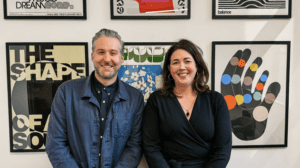How many times in the past 15 years have you lectured your frustratingly undiscerning close ones – usually those older than you – for believing everything they see on the internet? Well, life comes at you fast, doesn’t it? In 2023, you might now find yourself scratching your head, watching smartphone camera footage of giant Jacquemus bags cruising along the streets of Paris. You’re looping the video for the second or third time, squinting, then asking yourself: it can’t be real, can it?
This new form of reality-bending media has been dubbed as FOOH (or fake-out-of-home), and has been the burning topic on the marketing world’s lips for the entirety of the summer. The art form usually involves the addition of giant CGI products to mobile-shot footage of OOH city locations. Seemingly, the objective is to capture attention by duping audiences into a short state of disbelief, poking them to ask the question: is this real or not?
After months of fanfare has continued to grow for this type of media with each viral execution, right on time, we now have an alternative thread of discourse which stands to shine a negative light on FOOH. Is FOOH misleading audiences? Is it harmful to the OOH industry? Is it quickly getting very old and tired, anyway? The answer to each of those questions requires a nuanced one.
We turned to our Innovation team to help answer each of these questions. On the topic of potential harm to audiences via deception, our Innovation Director, Jordan, says that this is a common concern with the advent of new media formats:
“We have historically always had a tendency to invest blind trust in new centralised sources of truth, especially those driven by new, sophisticated technologies, which get closer and closer to seeming like real-life. You might think that tension contains itself solely to the internet age, but this definitely isn’t the case.
85 years ago, when a relatively new media format in radio reached mass adoption in the US, a radio drama broadcast of The War of the Worlds contained a news bulletin detailing aspects of a Martian invasion. Lo and behold, droves of war-anxious audiences believed it to be true, as they had just newly become heavily reliant on radio for their news.
Things like this are all par for the course with new media formats, until the right regulation is introduced and the format becomes familiar. But in the instance of FOOH, in my view, there is little to no room for harming audiences through deception, apart from those who are sensitive to feeling a bit foolish for believing!”
In fact, instead of harming audiences, FOOH seems to be getting mass buy-in because of its artificiality, showing that any perceptions of this format getting old or tired are solely contained in our marketing bubble. Taken from a sample of FOOH content during the months April to August 2023 (Tagger), brands that have jumped in have achieved 1,701% – 16,441% more engagement on their FOOH videos than on the average engagement from their previous 30 posts, with the best examples of success coming from fashion and beauty.
Source: The Berry
Maybelline’s Sky High mascara example is perhaps the most viral, depicting the attachment of giant eyelashes to the top of a tube train, which are brushed by a giant Maybelline mascara as it drives by. This video alone achieved 451% more engagement than their previous 30 posts combined, with droves of positive sentiment centered around the fact they actually loved the deceptive nature of the ad.
Despite the fact marketers continually evangelise for authenticity at any cost, Jonnie, our Music Partnerships manager, believes that audiences are more than willing to suspend their desire for authenticity in order to be entertained on social media
“First of all, it’s important to point out that entertainment and authenticity are never mutually exclusive. Live music, family vlogs, and documentaries can be just as entertaining as a fictional Netflix series.
But content that is absent of authenticity allows our imaginations as marketers to run wild and ensure that there is diversity and innovation in the media we are consuming. Consumers do not want the same old, same old every time they open the app, and I would stress that we as an industry do not want this either!
Ultimately, we are in a dogfight for attention everyday, and for that reason, there has never been a greater need to be inventive. My view is that invention exists more in a frame of mind that pushes authenticity further down the menu and prioritises entertainment, like FOOH does. And why shouldn’t we use a medium that helps us achieve incredible organic results at a time when we’re all being asked for our budgets to work harder?!”
@maybelline 📣 All aboard the Sky High Mascara Express ✨🚄 After hitting the NYC Streets, we’re taking over London💂🇬🇧 We are on the move with #SkyHighMascara elevating your lash game to new heights🌤️ 🌇 it’s guaranteed to serve limitless lash length 📏 and full volume😍 #Maybelline ♬ original sound – Maybelline NY
Of course, just because examples so far haven’t been harmful, it doesn’t mean we should turn a blind eye altogether. As AI democratises skills for everybody and allows for the generation of synthetic audio, imagery, and deep fakes, there is an industry wide need for legislation which enforces the labelling of assets that are artificial, especially those masquerading as the real thing. FOOH also exists in this world.
Whilst each platform develops its own solutions – with X (Twitter) opting for crowdsourcing moderation with community notes, TikTok asking for self-moderation with threat of consequence, and Meta releasing self-labeling tools if you use their AI – we are embarking upon a messy ecosystem where there is indisputably more margin for audience harm.
Agencies like Ogilvy have taken it on themselves to self-label when content has been produced through use of AI, and if a joined up effort from social platforms is too much to ask, it may fall on the industry to help create best practice with legislators in order to protect our own industry from any potential disrepute upon the horizon.
When you peel away concerns about consumer harm and the potential longevity of FOOH, you’re left addressing the concerns of the OOH industry. It’s within this arena where your empathy should be most directed, as FOOH is a sample of what is to come when our environments become virtual, immersive, and removed from the real world. The real world where JCDecaux, Clear Channel, Global Outdoor, TFL, and others rule the roost.
McKinsey found that Gen Z, millennials, and Gen X consumers expect to spend between four and five hours a day in the metaverse in the next five years, where large-scale brand advertisement will be completely democratised, without limits, and potentially, completely decentralised, too.
The metaverse is completely at odds with authenticity, where humans adopt avatar appearances to explore synthetic worlds, with a goal to be entertained through escapism. Is the outrage at FOOH a sign of the resistance that legacy marketers will have as we edge closer and closer to the future of online media? Ocean have already pioneered in examples of DOOH in specific immersive environments, but decentralisation and fragmentation will mean OOH buyers need to be nimble-footed.
Our Business Strategist, Rob, believes metaverses could completely reimagine the way in which media is bought, which is why the whole industry should be wise to the implications that Web3 brings with it:
“Augmented Reality and CGI / FOOH ads are a stepping stone to virtual worlds. Media fragmentation means that competition for attention is at an all time high and is only headed in one direction.
Clearly not many people are prepared to wear massive VR headsets just yet, however, Apple Vision Pro may be the driver the industry is looking for. Of course, younger generations, such as Gen Alpha may come to be considered VR natives, who have moved way beyond the current question of ‘is this real?’
In virtual worlds, marketing will evolve further and take different forms. We already see static in-game billboards sitting alongside race-tracks, advertising Gatorade – but this is a rudimentary version of what could be.
The direction of travel appears to involve the democratisation of CGI tools and a user preference to play with and remix brands. Combined, I believe we will see companies open up their brand assets, enabling creators in spaces such as Roblox, Sandbox and Fortnite to produce fantastic CGI, which is a fundamentally different way of assessing brand engagement.
In the meantime, we’re at an interesting juncture: Web 2.5. Where virtual and IRL co-exist and blend, but there are no rules, benchmarks or disclosure.”






